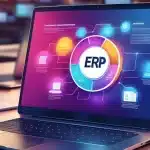I often see businesses struggle with complex legacy systems that hinder their growth, making a strategic cloud migration necessary. Sticking to outdated on-premise servers limits flexibility and slows down innovation significantly.
These limitations lead to operational inefficiencies, but implementing robust ERP software can streamline the transition. This solution centralizes data management and ensures a seamless shift to a modern cloud environment.
In this guide, I will walk you through the essential strategies to navigate this digital transformation successfully. Alamin kung paano mag-migrate sa cloud ngayon!
Key Takeaways
|
Table of Contents
What Is Cloud Migration and Why Is It Important for Business?
Cloud migration involves moving digital assets like data and applications from on-premise servers to a cloud infrastructure. This process shifts your IT operations to a more dynamic environment rather than relying on physical hardware.
This transition is crucial because it allows businesses to access scalable resources and advanced technologies like AI. It eliminates the heavy costs of maintaining local data centers while boosting operational agility.
Key Benefits of Cloud Migration for Business Growth
Adopting a cloud-based infrastructure offers transformative advantages that directly impact your bottom line. Here are the primary benefits that drive sustainable business growth through migration.
- Cost Efficiency
Moving to the cloud shifts costs from capital expenditure to operational expenditure, reducing upfront hardware investments. This pay-as-you-go model allows for more predictable and flexible budget allocation. - Scalability and Flexibility
Cloud environments allow you to instantly scale computing resources up or down based on real-time demand. This flexibility supports traffic spikes during marketing campaigns without requiring physical server upgrades.
The 6 R’s Strategy for Cloud Migration
Selecting the right approach for each application is vital for a smooth transition to the cloud. The “6 R’s” framework helps you categorize and plan the migration path for your IT portfolio.
- Rehosting (Lift and Shift)
Rehosting moves applications to the cloud without changing their underlying code or architecture. This strategy offers the fastest migration route with minimal risk for simple applications. - Replatforming (Lift and Reshape)
Replatforming involves making minor optimizations to the application to leverage specific cloud capabilities. This approach balances speed with improved performance without a total redesign. - Repurchasing (Drop and Shop)
Repurchasing replaces legacy systems with a new cloud-native product, typically a SaaS solution. This strategy reduces maintenance burdens by switching to modern platforms like Salesforce. - Refactoring / Re-architecting
Refactoring requires re-architecting the application’s code to fully utilize cloud-native features like microservices. This complex method maximizes long-term scalability and efficiency for core business applications. - Retiring
Retiring involves identifying and turning off applications that are no longer useful or functional. This step cleans up your IT portfolio and reduces unnecessary licensing costs before migration. - Retaining
Retaining keeps certain applications on-premise due to strict compliance rules or recent hardware investments. This often leads to a hybrid cloud model where only specific workloads move to the cloud.
How Do You Execute a Successful Cloud Migration Process?
A successful migration requires a structured approach to minimize risks and ensure operational continuity. Following these logical steps will help you navigate the complexities of moving your digital assets.
- Assessment and Planning
The team conducts a thorough inventory of all applications and data to understand system dependencies. This phase defines clear business goals and technical requirements to guide the strategy. - Selection of Cloud Model and Provider
You must choose the appropriate cloud model and provider based on security and budget needs. This step involves evaluating services from major vendors like AWS or Azure to find the best fit. - Designing the Cloud Environment
Technical teams design the target cloud environment, including network configurations and security protocols. This design ensures the new infrastructure aligns with scalability and performance goals. - Migration Execution
The actual transfer of data and workloads occurs based on the selected strategy for each application. Teams often start with low-risk pilot migrations to test the process before full deployment. - Testing and Validation
Comprehensive testing verifies that all applications function correctly and securely in the new environment. Once validated, the final cutover redirects user traffic to the cloud system. - Optimization and Post-Migration Management
Continuous monitoring of performance and costs ensures the cloud environment remains optimized. This phase involves right-sizing resources and automating processes to maintain efficiency.
Challenges of Cloud Migration and How to Overcome It
While beneficial, the journey to the cloud presents obstacles that can hinder project success if ignored. Identifying these common hurdles early allows you to implement effective mitigation strategies.
- Unexpected Costs
Cloud spending can exceed budgets without proper monitoring and governance policies in place. Conducting a detailed Total Cost of Ownership analysis helps control and predict these expenses. - Security Risks and Compliance
Data breaches and compliance issues can arise if security configurations are not properly managed. Implementing a robust security architecture and using cloud-native tools mitigates these vulnerabilities. - Technical Complexity and Downtime
Migrating complex legacy applications often leads to integration issues and potential downtime. Mitigate this by performing pilot migrations and establishing a solid disaster recovery plan. - Skill Gaps
Internal IT teams may lack the specific expertise required to manage dynamic cloud environments. Investing in training or partnering with experienced consultants bridges this knowledge gap effectively. - Vendor Lock-in
Relying too heavily on proprietary services from a single provider can make future switching difficult. Adopting multi-cloud strategies or open-source technologies like containers reduces this dependency.
KPI Metrics for Cloud Migration
Measuring the success of your migration requires tracking specific indicators that align with your business objectives. These metrics provide data-driven insights to validate the value of your cloud investment.
- Total Cost of Ownership (TCO)
TCO compares the comprehensive costs of running workloads in the cloud versus on-premise. This metric tracks financial efficiency and potential savings over time. - Application Availability (Uptime)
This KPI measures the uptime and reliability of applications after moving to the cloud environment. High availability indicates a stable infrastructure that supports continuous business operations. - Latency and Performance
Performance metrics track the speed of application response times and data processing. Lower latency confirms that the cloud architecture is optimized for user experience.
Optimize Your Business’ Cloud Migration With HashMicro ERP Software
Integrating HashMicro ERP Software simplifies the complex process of moving data and operations to a new environment. This solution ensures your core business processes remain streamlined and connected throughout the transition.
- Centralized Database
This feature consolidates all business data into a single platform to ensure consistency across the organization. - Real-Time Analytics Dashboard
The dashboard aggregates data streams to provide immediate visibility into key performance indicators. - Scalable Architecture
The system architecture adjusts its resource allocation to accommodate growing transaction volumes. - Automated Workflow Management
This tool triggers automatic sequences for cross-departmental tasks to reduce manual intervention. - Comprehensive Security Protocols
Security features manage user access rights and encrypt sensitive data within the cloud system.
Experience how our integrated solution can streamline your migration and enhance operational efficiency. Book a free demo today to see the system in action.
Conclusion
Cloud migration acts as a strategic foundation for businesses aiming to stay competitive in a digital landscape. It enables organizations to achieve higher scalability and operational agility through careful planning.
Integrating a robust system like HashMicro ERP Software ensures your processes are optimized for this new environment. This alignment maximizes the value of your technology investment and supports sustainable growth.
Take the next step in your transformation journey by scheduling a free demo with our experts. I-migrate ang iyong data sa cloud kasama namin ngayon!
FAQ on Cloud Migration
-
What is the first step to take when planning a cloud migration?
The most crucial first step is the assessment phase. This includes creating an inventory of all applications and infrastructure, understanding dependencies, and setting clear business goals for the migration.
-
How long does a cloud migration project usually take?
The duration varies widely depending on the complexity and size of the IT environment. Simple applications may take a few months, while large-scale enterprise migrations can take more than a year.
-
How do you choose between public, private, or hybrid cloud?
The choice depends on security needs, compliance requirements, and budget. Public cloud provides scalability and cost efficiency, private cloud offers maximum control and security, while hybrid combines both for greater flexibility.
-
What are the most common mistakes to avoid during cloud migration?
Common mistakes include poor planning, lack of total cost analysis (TCO), overlooking security, and insufficient in-house expertise. Avoid these by conducting a thorough assessment and working with specialists when needed.
-
When is the right time for a business to consider migrating to the cloud?
The right time is when on-premise infrastructure starts limiting growth, maintenance costs become too high, or the company needs greater agility and scalability to compete and innovate.










































